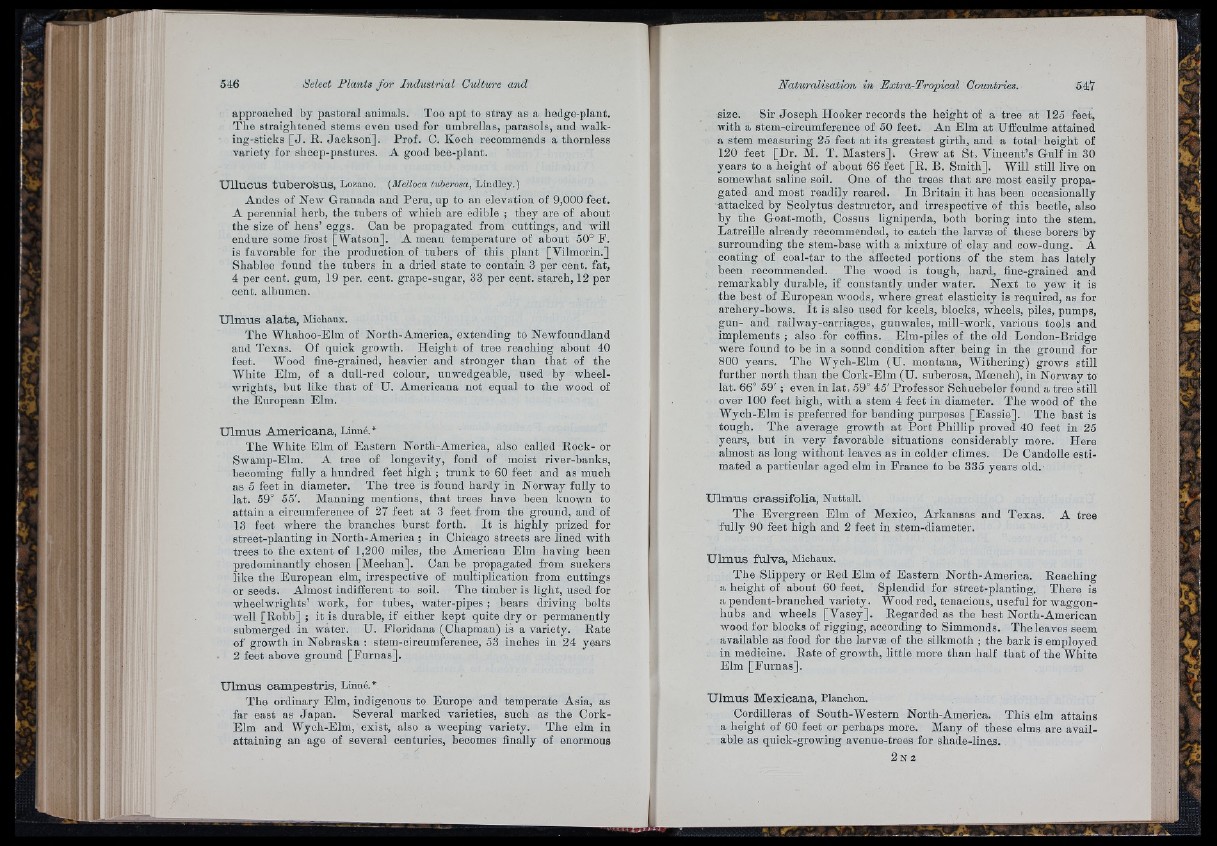
approached by pastoral animals. Too apt to stray as a hedge-plant.
The straightened stems even used for umbrellas, parasols, aud walking
sticks [ J . R. Jackson], Prof. C. Koch recommends a thornless
variety for sheep-pastures. A good bee-plant.
XJIIUCUS tu b e r o 'SU S , Lozano. [Melloca tuberosa, Lindley.)
Andes of New Granada and Peru, up to an elevation of 9,000 feet.
A perennial herb, the tubers of wliich are edible ; they are of about
the size of hens’ eggs. Can be propagated from cuttings, and will
endure some frost [Watson]. A mean temperature of about 50° F.
is favorable for the production of tubers of this plant [Vilmorin.]
Shablee found the tubers in a dried state to contain 3 per cent, fat,
4 per cent, gum, 19 per. cent, grape-sugar, 33 per cent, starch, 12 per
cent, albumen.
Ulmus alata, Michaux.
The Whahoo-Elm of North-Ameriea, extending to Newfoundland
and Texas. Of quick growth. Height of tree reaching about 40
feet. Wood fine-grained, heavier and stronger than th a t of the
White Elm, of a dnll-red colour, unwedgeable, nsed by wheelwrights,
but like th a t of U. Americana not equal to the wood of
the European Elm.
Ulmus Americana, Linné.*
The White Elm of Eastern North-Ameriea, also called Rock- or
Swamp-Elm. A tree of longevity, fond of moist river-banks,
becoming fully a hundred feet high ; trunk to 60 feet and as much
as 5 feet in diameter. The tree is found hardy in Norway fully to
lat. 59° 55'. Manning mentions, th a t trees have been known to
attain a circumference of 27 feet at 3 feet from the ground, and of
13 feet where the branches burst forth. I t is highly prized for
street-planting in North-America ; in Chicago streets are lined with
trees to the extent of 1,200 miles, the American Elm having been
predominantly chosen [Meehan]. Can be propagated from suckers
like the European elm, irrespective of multiplication from cuttings
or seeds. Almost indiiferent to soil. The timber is light, used for
wheelwrights’ work, for tubes, water-pipes ; bears driving bolts
well FRobb] ; it is durable, if either kept quite dry or permanently
submerged in water. U. Floridaua (Chapman) is a variety. Rate
of growth in Nebraska : stem-circumference, 53 inches in 24 years
2 feet above ground [Fu rn a s].
Ulmus campestris, Linné.*
The ordinary Elm, indigenous to Europe and temperate Asia, as
far east as Japan. Several marked varieties, such as the Cork-
Elm aud Wych-Elm, exist, also a weeping variety. The elm iu
attaining an age of several centuries, becomes finally of enormous
size. Sir Joseph Hooker records the height of a tree at 125 feet,
with a stem-circumference of 50 feet. An Elm at USculme attained
a stem measuring 25 feet a t its greatest girth, and a total height of
120 feet [Dr. M. T. Masters]. Grew at St. Vincent’s Gulf iu 30
years to a height of about 66 feet [R. B. Smith]. Will still live ou
somewhat saline soil. One of the trees that are most easily propagated
and most readily reared. In Britain it has been occasionally
attacked by Scolytus destructor, and irrespective of this beetle, also
by the Goat-moth, Cossus ligniperda, both boring into the stem.
Latreille already recommended, to catch the larvæ of these borers by
surrounding the stem-base with a mixture of clay and cow-dung. A
coating of coal-tar to the affected portions of the stem has lately
been recommended. The wood is tough, hard, fine-grained and
remarkably durable, if constantly under water. Next to yew it is
the best of European woods, where great elasticity is required, as for
archery-bows. I t is also used for keels, blocks, wheels, piles, pumps,
gun- and railway-carriages, gunwales, mill-work, various tools and
implements ; also for coffins. Elm-piles of the old London-Bridge
were found to be in a sound condition after being in the ground for
800 years. The Wych-Elm (U. montana, Withering) grows still
further north than the Cork-Elm (U. suberosa, Moench), in Norway to
lat. 66° 59' ; even in lat, 59° 45' Professor Schuebeler found a tree still
over 100 feet high, with a stem 4 feet in diameter. The wood of the
Wych-Elm is preferred for bending purposes [Eassie]. The bast is
tough. The average growth a t P o rt Phillip proved 40 feet in 25
years, but in very favorable situations considerably more. Here
almost as long without leaves as in colder climes. De Candolle estimated
a particular aged elm in France to he 335 years old.
Ulmus crassifolia, Nuttall.
The Evergreen Elm of Mexico, Arkansas and Texas,
fully 90 feet high and 2 feet in stem-diameter.
A tree
Ulmus fulva, Michaux.
The Slippery or Red Elm of Eastern North-America. Reaching
a height of about 60 feet. Splendid for street-planting. There is
a pendent-branched variety. Wood red, tenacious, useful for waggon-
hubs and wheels [Vasey]. Regarded as the best North-American
wood for blocks of rigging, according to Simmonds. The leaves seem
available as food for the larvæ of the silkmoth ; the bark is employed
iu medicine. Rate of growth, little more than half th a t of the White
Elm [Fu rn as].
Ulmus Mexicana, Planchón.
Cordilleras of South-Western North-America. This elm attains
a height of 60 feet or perhaps more. Many of these elms are available
as quick-growing avenue-trees for shade-lineis.
2 N 2